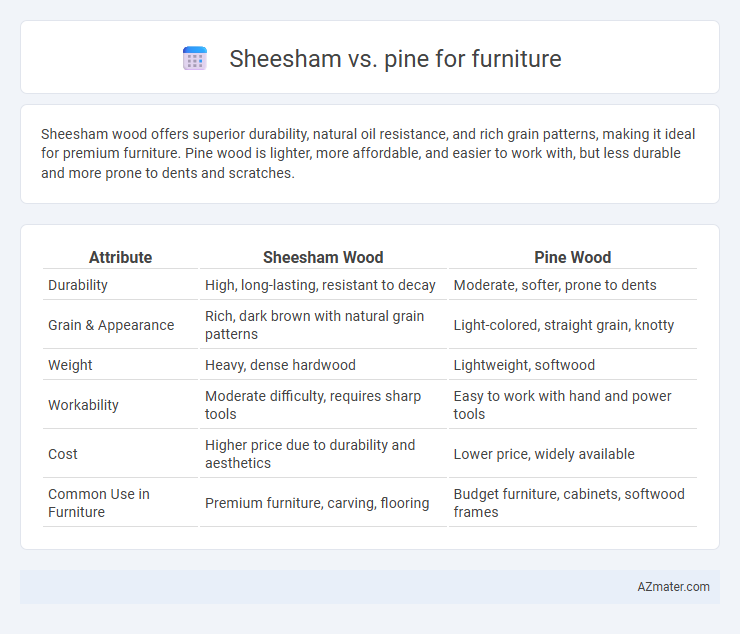Sheesham wood offers superior durability, natural oil resistance, and rich grain patterns, making it ideal for premium furniture. Pine wood is lighter, more affordable, and easier to work with, but less durable and more prone to dents and scratches.
Table of Comparison
| Attribute | Sheesham Wood | Pine Wood |
|---|---|---|
| Durability | High, long-lasting, resistant to decay | Moderate, softer, prone to dents |
| Grain & Appearance | Rich, dark brown with natural grain patterns | Light-colored, straight grain, knotty |
| Weight | Heavy, dense hardwood | Lightweight, softwood |
| Workability | Moderate difficulty, requires sharp tools | Easy to work with hand and power tools |
| Cost | Higher price due to durability and aesthetics | Lower price, widely available |
| Common Use in Furniture | Premium furniture, carving, flooring | Budget furniture, cabinets, softwood frames |
Introduction to Sheesham and Pine Wood
Sheesham wood, also known as Indian rosewood, is renowned for its durability and rich, dark grain, making it a popular choice for high-quality furniture. Pine wood, in contrast, is a softer, lighter timber favored for its affordability and ease of use in crafting rustic or casual furniture pieces. Both woods offer distinct aesthetic and functional qualities, with Sheesham prized for longevity and Pine valued for versatility.
Key Differences Between Sheesham and Pine
Sheesham wood, known for its rich grain patterns and natural durability, offers greater resistance to decay and insect attacks compared to Pine, which is softer and more prone to dents and scratches. Pine furniture is typically lighter in color and weight, making it easier to move and more affordable but less sturdy than Sheesham, which has a denser structure ideal for long-lasting pieces. The natural oils in Sheesham also provide a polished finish without extensive treatment, whereas Pine often requires additional sealing and protection to maintain its appearance and longevity.
Appearance and Grain Patterns
Sheesham wood features rich, dark brown hues with golden or reddish streaks, offering a luxurious and elegant appearance, while pine exhibits a lighter, creamy yellow color with occasional knots, giving a rustic and casual look. The grain pattern in Sheesham is dense and varied, often displaying prominent swirls and intricate lines, whereas pine shows a straight, uniform grain with a more simplistic and consistent texture. These differences influence furniture aesthetics, with Sheesham suited for sophisticated designs and pine ideal for light, airy interiors.
Durability and Longevity Comparison
Sheesham wood, also known as Indian Rosewood, offers exceptional durability due to its dense grain and natural resistance to decay and termites, making it ideal for long-lasting furniture. Pine, a softwood, is more prone to dents, scratches, and insect damage, requiring regular maintenance to extend its lifespan. Furniture made from Sheesham can last several decades with minimal wear, while pine furniture typically has a shorter life span and may need replacement or refurbishment more frequently.
Maintenance and Care Requirements
Sheesham wood requires regular oiling and polishing to maintain its rich, dark finish and prevent cracking, while pine demands less frequent maintenance but is more susceptible to dents and scratches due to its softer nature. Pine furniture benefits from occasional waxing and gentle cleaning to protect its lighter surface, whereas Sheesham's dense grain naturally resists pests and moisture better. Both woods need protection from excessive humidity and direct sunlight to preserve durability and appearance over time.
Cost and Affordability Analysis
Sheesham wood, known for its durability and rich grain, typically commands higher prices due to limited supply and longer growth cycles, making it a premium choice in furniture. Pine wood offers a more cost-effective alternative with faster growth and wider availability, making it ideal for budget-conscious buyers without sacrificing basic strength. When comparing Sheesham vs Pine for furniture, affordability favors pine, but sheesham's investment reflects in longevity and aesthetic value.
Environmental Impact and Sustainability
Sheesham wood is a sustainable option due to its fast growth rate and ability to thrive with minimal chemical inputs, contributing positively to forest conservation. Pine, often sourced from managed plantations, supports reforestation efforts but may involve more intensive use of pesticides and fertilizers, impacting its environmental footprint. Both woods offer eco-friendly furniture choices when harvested responsibly, but sheesham's durability and slower decay rate can result in longer-lasting products, reducing overall resource consumption.
Suitability for Different Furniture Types
Sheesham wood, known for its durability and rich grain patterns, is ideal for high-end furniture pieces like cabinets, dining tables, and decorative items that require strength and aesthetic appeal. Pine wood, being lightweight and soft, suits furniture such as children's beds, casual chairs, and rustic-style pieces where ease of carving and affordability are prioritized. Both woods offer versatility, but Sheesham is preferred for long-lasting, polished furniture, while Pine excels in budget-friendly, easily customizable designs.
Pros and Cons of Sheesham vs Pine
Sheesham wood offers durability, rich grain patterns, and resistance to termites, making it ideal for high-quality furniture, while Pine is lightweight, cost-effective, and easier to work with but less durable and prone to dents and scratches. Sheesham's natural oils protect it from moisture, whereas Pine requires treatment to avoid warping and decay. Pine furniture often suits rustic or casual styles, but Sheesham is preferred for elegant, long-lasting pieces with a polished finish.
Which Wood is Better for Furniture?
Sheesham wood offers superior durability, resistance to termites, and a rich grain pattern, making it ideal for high-end furniture that lasts long. Pinewood is softer, lightweight, and more affordable, suitable for budget-friendly or rustic-style furniture but may dent or scratch more easily. For long-term investment and aesthetic appeal, Sheesham wood is generally considered better for furniture.

Infographic: Sheesham vs Pine for Furniture
 azmater.com
azmater.com